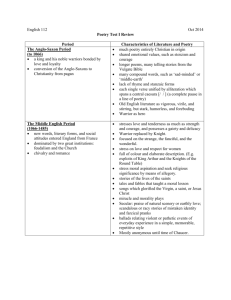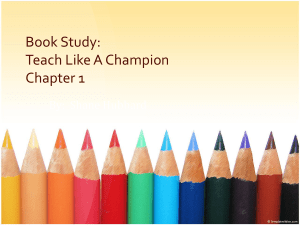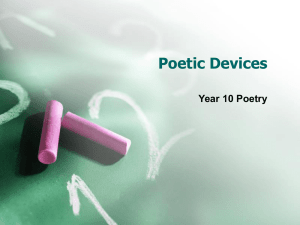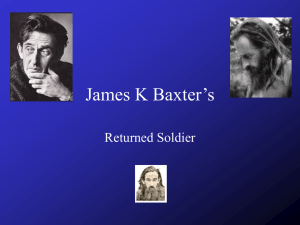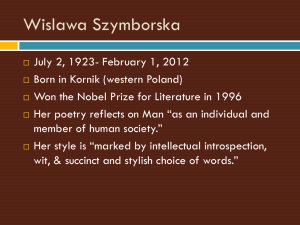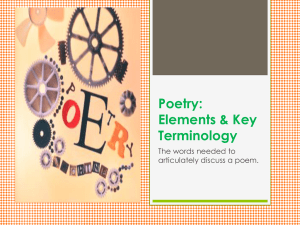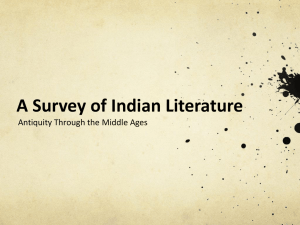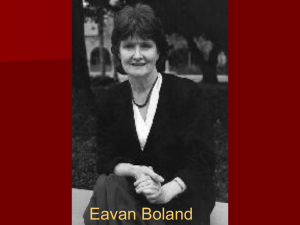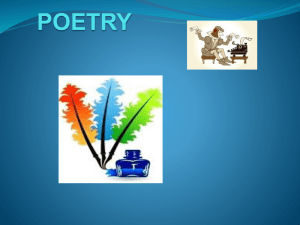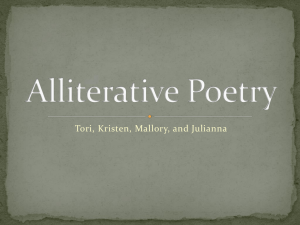Poetry Pre-test and notes
advertisement
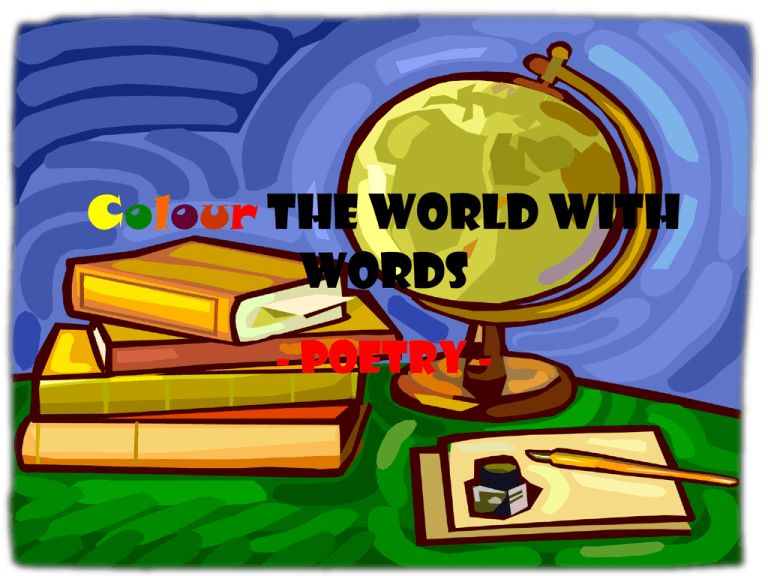
Colour the world with words - Poetry - Poetry Pretest ing – Testing – testing... Define the following: • Alliteration • Assonance • Sibilance • Onomatopoeia What do we call: • Two lines of verse • Eight lines of verse • Four lines of verse • Three lines of verse Now do these: Now answer these: • • • • Metaphor Simile Personification Symbol • • • • What poetic form has 14 lines of verse? What is first-person voice poetry called? What is second person voice in poetry called? What is third-person voice in poetry called? Testing, testing, testing...2 • What is the difference between figurative and literal language? Rewrite the following examples of figurative language into literal language. • “It is raining cats and dogs.” • “He was walking on cloud nine” • “My heart was beating like a drum.” • How is imagery different from an image? • Name four main methods of creating figurative imagery. So ... What is Poetry? • a written composition in which the words are chosen for their sound and the images/ideas they suggest, not just their obvious meaning. The words are arranged in separate lines which often, but not always, end in rhyme. GETTING STARTED ON POETRY • To respond to poetry you need to have a considerable arsenal of language tools and reading skills at your disposal. First we will start by building a glossary of key knowledge, vocabulary and skills. Poetry... has three basic “voices”: • Lyric – first person • Dramatic – second person • Narrative – third person. Lyric • - this is the first person voice of poetry and uses first-person singular or plural pronouns such as ‘I’, ‘me’, ‘mine’ (singular) or ‘us’, ‘we’, ‘our’, (plural). The content presents the thoughts and feelings of a single speaker, and the poet and the poem’s speaker seem almost the same. It is the most emotional voice. A lyric expresses subjective feelings, the personal hopes, joy, sorrow, fantasies of the author. These poems are often intense and short. Dramatic • - uses second person pronouns such as ‘you’, (thee), ‘your’ (thine) and presents the voice of an imaginary character speaking directly to an imaginary audience. The writer does not intrude to offer his comments, but allows the reader to decide what value to place on the speaker’s words. It relies on irony, as more is revealed to the reader about the speaker, than s/he intends. Narrative • tells a story and is usually told using third person pronouns – ‘they’, ‘he’, ‘she’, ‘them’, etc. This is the ‘eye-of-God’ objective voice of poetry. There are three main classifications: Ballads, Epics and Romance. Sound Devices There are four key types: • • • • Alliteration Assonance Sibilance Onomatopoeia Alliteration • The deliberate repetition of an initial consonant sound in a group of closely connected words – at least two. E.g. “Rifle’s rapid rattle” – from “Anthem for Doomed Youth” by Wilfred Owen. Purposes: 1. To create an emotion, tone, attitude, 2. To mimic the sound of an aspect of content – such as the sound of gunfire in the example above. 3. To link and reinforce ideas. Assonance • The deliberate repetition of vowel sounds in a group of nearby words. It may occur at the start or within the words. E.g. “fumbling”, “clumsy”, “stumbling” from “Dulce et Decorum Est” by Wilfred Owen. Purposes: 1. To create an emotion, tone, attitude. 2. To mimic the sound of an aspect of content. 3. To link and reinforce ideas, such as in the example above. Sibilance • The deliberate repetition of soft consonant sounds such as ‘s’, and ‘f’ in a group of closely connected words. E.g. ‘in hearts at peace, under an English heaven” from “The Soldier” by Rupert Brooke. Purposes: 1. To create an emotion, tone, attitude, such as the serenity and acceptance created in the example above. 2. To mimic the sound of an aspect of content. 3. To link and reinforce ideas. Onomatopoeia • A word which is written in such a way that it mimics the sound it represents. The sound is associated with an action. E.g. “You mumble, and sigh” from “The Dug-out” by Sigfried Sassoon. Purpose: 1. To reinforce imagery (visual aspects of poems) with sound. 2. To give us a familiar sound we can relate to an action. Metaphor This is a direct comparison between two unlike things which is used to point out their meanings and, therefore, enrich the reader’s understanding. E.g. “The moon was a ghostly galleon” from “The Highwayman” by Alfred Noyes. The moon is compared to a ghost, so it is pale and seethrough, floating in the sky and a bit scary. Simile This is a less direct comparison than a metaphor because it uses the words “like” or “as” to connect the two unlike things. However, it works in a similar way and has the same purpose – to enrich the reader’s Understanding of something. E.g. “His eyes peer from his hair and beard like mice from a load of hay” (source unknown). This compares the hair of someone to hay (yellow, dry and messy), and his eyes to those of a mouse (small, brown, shining). Personification This is a special kind of metaphor which compares something to humans – it literally turns things and Ideas into humans by giving them human characteristics. It has a similar purpose to metaphor in that it enrich the reader’s understanding. E.g. “The mosterous anger of the guns...” From “Anthem for Doomed Youth by Wilfred Owen The guns are seen as almightily powerful and destructive, just like the Symbol A symbol is a concrete (something we can touch) representation of something abstract (an idea – something We cannot touch, taste, see, hear, smell). It’s purpose is to Help us to understand a lot about a concept by giving us something familiar to compare it to. The difference between a symbol and a metaphor or simile is that a comparison a symbol makes always remains the same, whereas the others are different. Symbol...cont E.g. Romantic love is always associated with a red rose. The red of the rose suggests love’s energy and passion; the thorns on the rose suggest it sometimes has hidden pain. Roses do not last in full bloom for very long, and this suggests that the first passion of romantic love does not last very long either.
